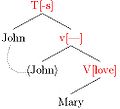- Mirror theory
-
In theoretical linguistics, mirror theory refers to a particular approach to the architecture of the language organ developed by Michael Brody, who claims his theory to be purely representational (unlike most of the current generative theories that are either derivational or combining derivation and representation).
Phrase Structure
There are several important respects in which mirror theory is different from more traditional theories of phrase structure in generative linguistics such as X-bar theory or bare phrase structure. The first principle, called mirror, states that the syntactic relation 'X complement of Y' is identical to an inverse-order morphological relation 'X specifier of Y'. Thus, the notions of 'syntactic' and 'morphological' specifiers and complements are crucial for the linearisation of syntactic structure and its mapping to the morphological component.
When the structure is pronounced, it linearises in the following order: specifiers precede heads, and heads precede their complements. So when a sentence like that in the diagram below is pronounced, 'John' precedes the V-v-T chain, which in turn precedes 'Mary', the latter being the specifier of V. However, English is a VO language, which means that the morphological word 'loves' associated with the V-v-T chain is spelled in v, deriving the correct word order.
Categories:
Wikimedia Foundation. 2010.

